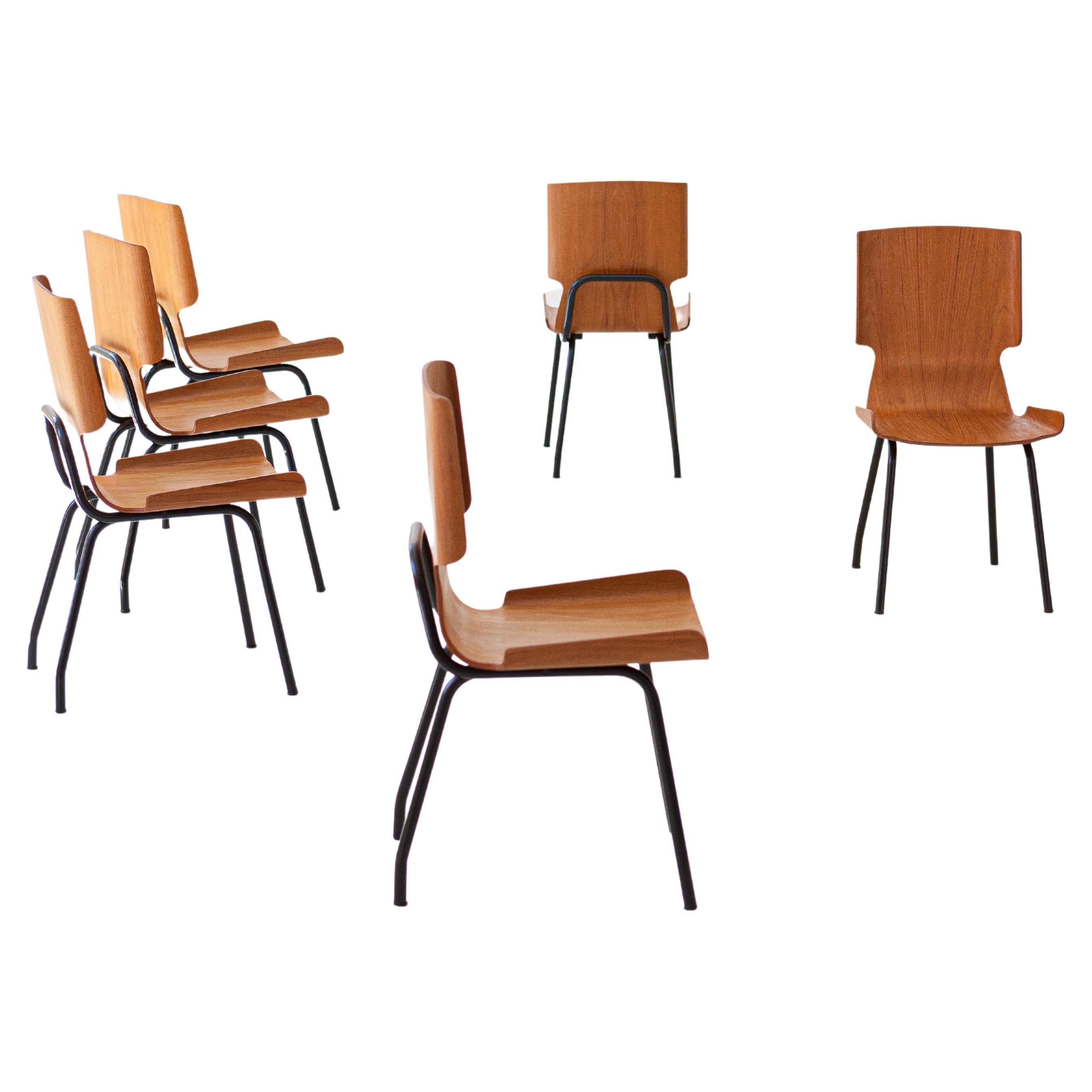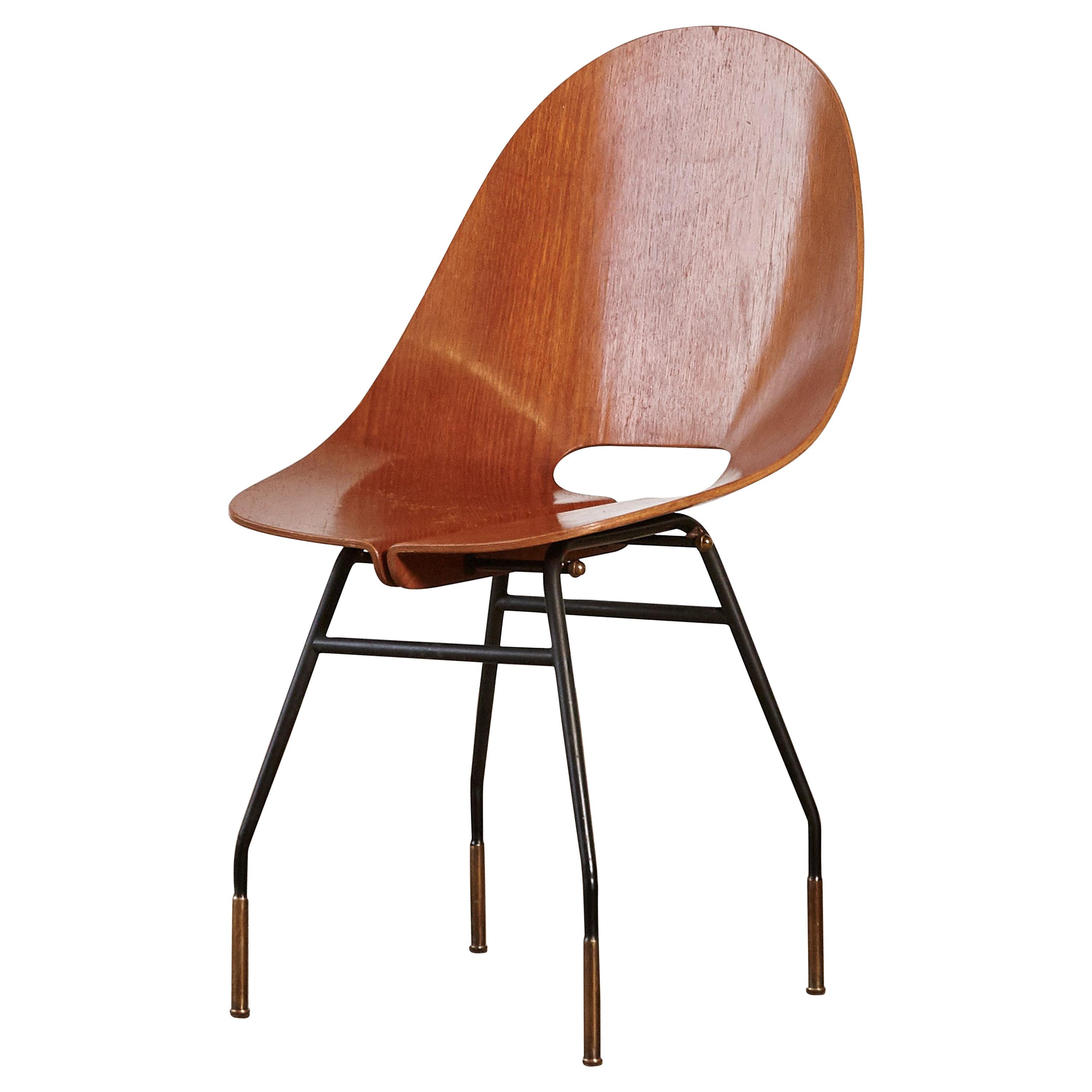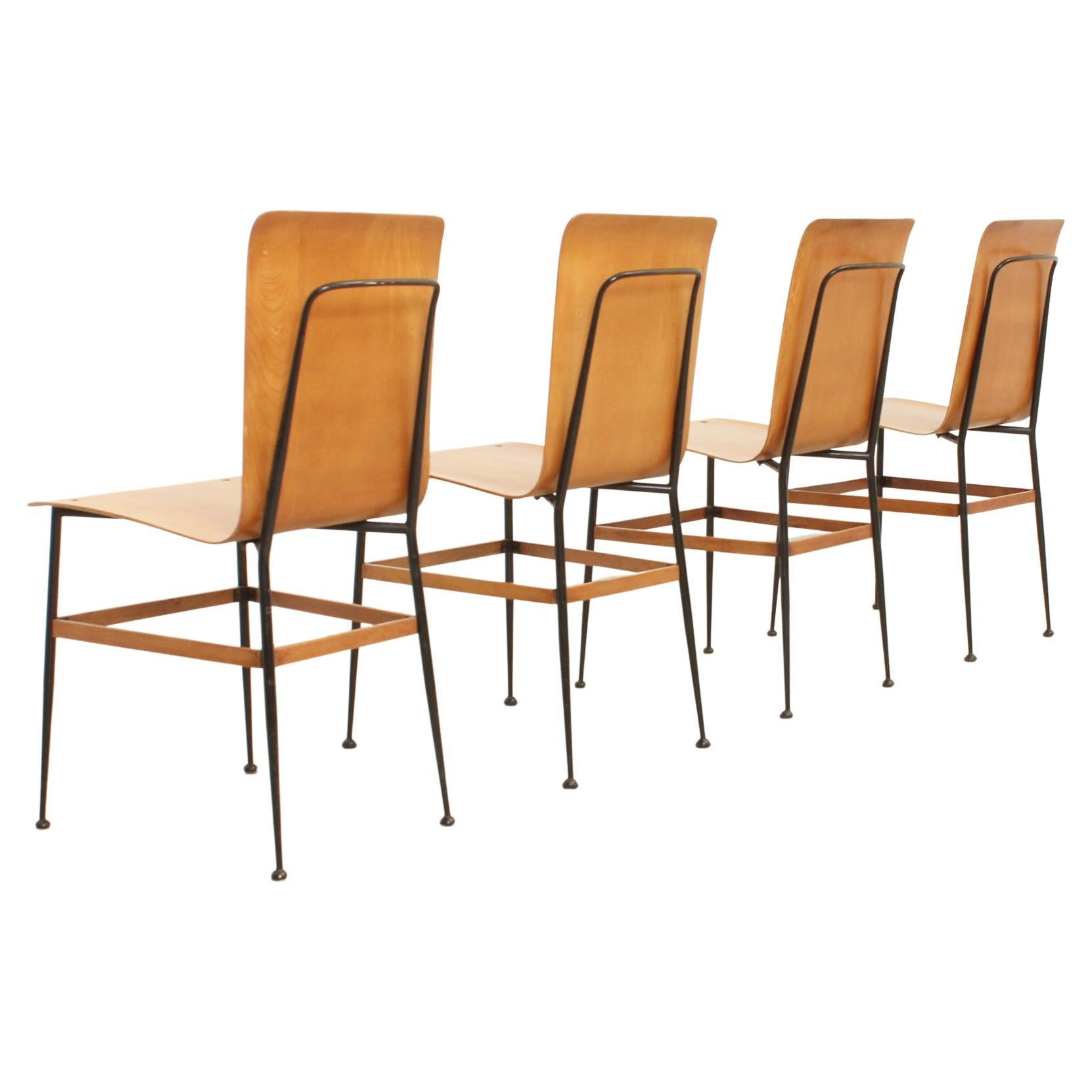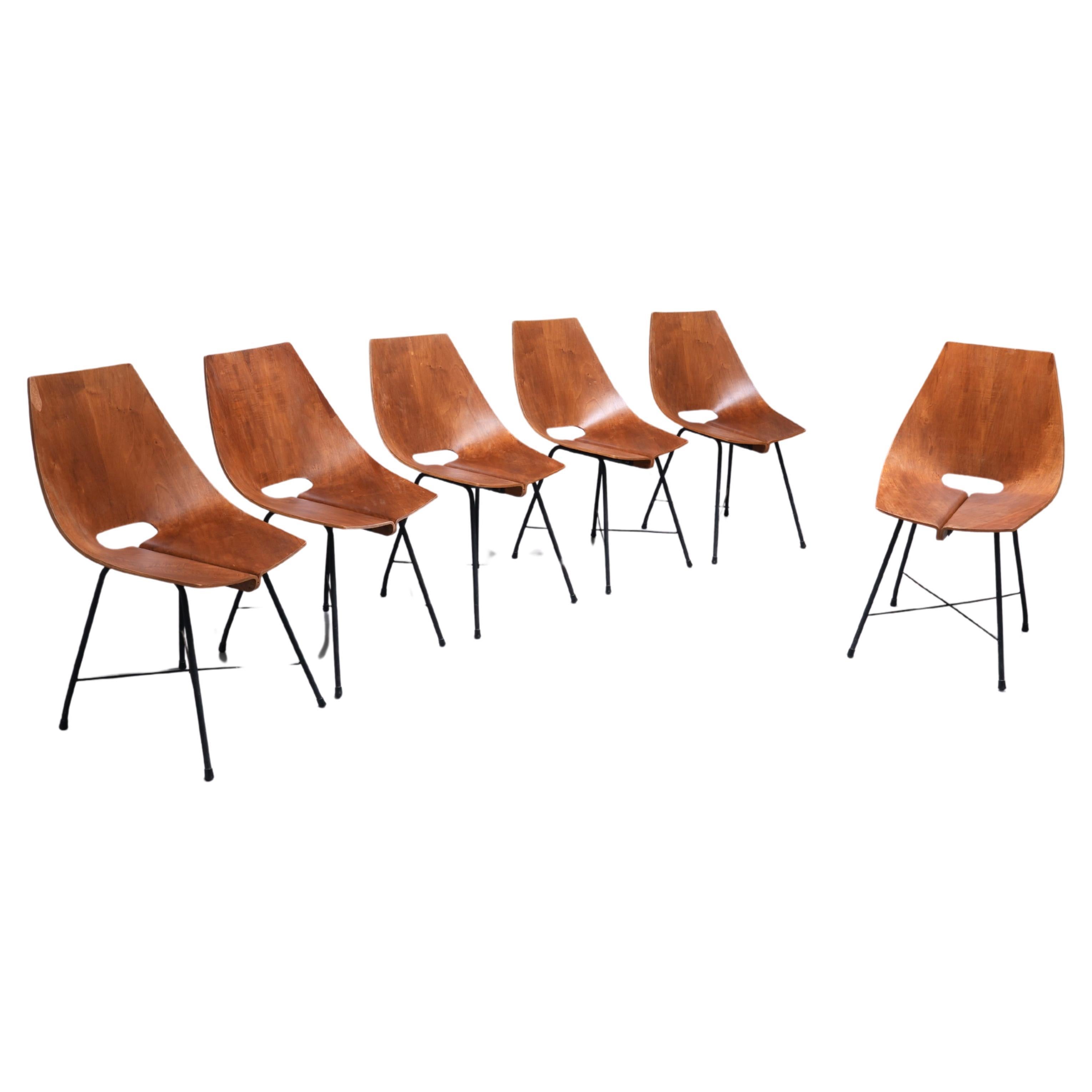Artículos similares a Carlo Ratti Set of Four Chairs in Plywood by Società Compensati Curvi 1950s
¿Quieres más imágenes o vídeos?
Solicita imágenes o vídeos adicionales al vendedor
1 de 9
Carlo Ratti Set of Four Chairs in Plywood by Società Compensati Curvi 1950s
Acerca del artículo
Set of four dining chairs with a frame in black lacquered metal and seat in curved plywood, attributed to Carlo Ratti and produced by Società Compensati Curvati in the 1950s.
In Italy, at the beginning of the XX century, industries of curved solid wood arose under license of Michael Thonet, and through the International Exhibitions the processing of curved wood became more and more widespread.
The Expo of the first decade was also attended by the wood manufacturers of Monza, while in 1905 Otto Helzer, in Switzerland, patented wooden structures in curved laminated, whose strength was equivalent to those in steel.
The Ratti brothers of Monza took their cue from the solid wood laminate to create furniture that, instead of wooden elements, used sheets of wood.
The brothers Ratti, Carlo and Mario, also began to follow the young artistic avant-gardes (cubism, futurism and abstractionism).
The mastery of wooden sculpture influenced Carlo in the design and realization of furniture of fine neo-plastic artistic workmanship and decò, receiving honors from the Prince of Piedmont Umberto di Savoia.
In 1919, in Milan, the first Lombard Exhibition of Decorative Arts was set up (later to become the Triennale) and the Ratti brothers exhibited their furniture in solid wood but also in curved panel with a new system of curvature, the one in Telo.
The canvas system was developed by the Ratti brothers with the help of a friend, Cesare Cantù.
They developed an elastomer bag in which the mould was inserted with the panel to be bent and, closing it with clamps, the air inside was removed, thus making the panel adhere to the mould.
Carlo and Mario found in the Telo system a means by which they could make objects and furniture in the three spatial directions with large surface curvatures, without limits of thickness and minimum radii of curvature.
In 1921 in Stuttgart the first Salone del Mobile was inaugurated and the Fratelli Ratti of Monza made itself known internationally by presenting solid wood furniture and also furniture in load-bearing plywood, flanked by furniture with framed and interchangeable covers.
The Expo became meeting places to verify and present the novelties in the furniture and industrialization sector and, with the development of Industrial Design, the first architects joined in the design of the furniture industries.
The Ratti Brothers, in the various international and national exhibitions, also presented incredible objects in their realization with the system in Telo.
After 1930 Carlo and Mario produced many containers for radio and folding chairs for cinema but in 1939 they divided and in Monza Mario remained who, with his sons Antonio and Angela, formed the Società Compensati Curvi.
Carlo moved to Lissone, forming with his sons Angelo and Piera and with her husband, Piero Berruti, the Industria Legni Curvati. After the war, a new bending system, the Mould and Counter-mould, was added to the existing systems from the 1950s.
After the war, the architects devoted themselves exclusively to the planning and reconstruction of the territory and the need to regain the markets put the industrialists in conditions to offer quality products, designed by architects-designers of the new generation.
Both Carlo Ratti’s and Mario’s firm began collaborating with world-famous architects such as Ignazio Gardella, Paolo Chessa, Vico Magistretti, the Castiglioni brothers, Vittoriano Vigano, Marco Zanuso, Carlo de Carli, etc.
In those years many technological objects were made with curved plywood bodies such as washing machines, televisions, radios, sewing machines, etc. while the production of furniture in a rationalistic style continued.
The new bending technologies, Mould and Counter-mould and High Frequency, allowed a remarkable mass production and, if the old system in Telo continued to exist to make extraordinary objects with Coons curves, especially the High Frequency spread all over the world.
The Japanese company Tendo Mokko invented this new bending system in 1948, trying to make plywood planes and, immediately, the company Ratti of Monza used it, while that of Lissone continued to make products with the old Mould and Counter-mould system.
This system used aluminum shapes unlike other systems that, instead, made wooden shapes, with considerable economic savings.
In 1954 a chair designed by Carlo de Carli for Cassina and made by Carlo Ratti won the "Compasso d'Oro" award as an object of considerable technical and aesthetic value.
In 1961 Carlo Ratti died and his sons Angelo and Piera, with her husband Piero Berruti, continued the activity while the third generation was entering the company.
The company transformed from Industria Legni Curvati into Carlo Ratti s.a.s and, since then, new collaborations with young architects allowed a new technological development.
Thus, the High Frequency system was introduced in the company, but the Mould and Counter-mould system was not abandoned and, above all, the Telo system that was still used for the production of samples and prototypes.
- Creador:Società Compensati Curvati (Fabricante)
- Atribuido a:Carlo Ratti (Diseñador)
- Dimensiones:Altura: 80 cm (31,5 in)Anchura: 50 cm (19,69 in)Profundidad: 45 cm (17,72 in)
- Se vende como:Juego de 4
- Estilo:Moderno de mediados de siglo (Del período)
- Materiales y técnicas:
- Lugar de origen:
- Época:
- Fecha de fabricación:1950s
- Estado:Desgaste acorde con la edad y el uso.
- Ubicación del vendedor:Montecatini Terme, IT
- Número de referencia:1stDibs: LU5304223682922
Acerca del vendedor
4,9
Vendedor Platino
Estos vendedores aprobados por expertos son los vendedores más experimentados de 1stDibs y los mejor valorados por nuestros clientes.
Vendedor de 1stDibs desde 2020
103 ventas en 1stDibs
Tiempo de respuesta usual: <1 hora
- EnvíoRecuperando presupuesto…Se envía desde: Florence, Italia
- Política de devoluciónLa devolución de este artículo puede iniciarse pasados 7 días del plazo de entrega.
Partes de esta página se han traducido automáticamente. 1stDibs no puede garantizar la exactitud de las traducciones. El inglés es el idioma predeterminado de este sitio web.
Más de este vendedorVer todo
- Augusto Bozzi Juego de cuatro sillas Ariston de madera contrachapada y metal by Saporiti Años 50Por Augusto Bozzi, Fratelli SaporitiConjunto de cuatro sillas de comedor modelo Ariston con estructura de madera contrachapada curvada y patas de metal lacado en negro. La silla Ariston fue diseñada por Augusto Bozzi ...Categoría
Vintage, Década de 1950, Italiano, Moderno de mediados de siglo, Sillas
MaterialesMetal
- Gio Ponti Juego de cuatro sillas de comedor Leggera by Cassina 1951 ItaliaPor Gio Ponti, CassinaJuego de cuatro sillas de comedor Leggera con estructura de madera lacada en negro y asiento de polipiel azul acolchado, diseñadas por Gio Ponti y fabricadas por Cassina en 1951. Le...Categoría
Vintage, Década de 1950, Italiano, Moderno de mediados de siglo, Sillas
Materialescuero de imitación, Madera
- Afra & Tobia Scarpa Juego de cuatro sillas 121 by Cassina Años 60 ItaliaPor Cassina, Afra & Tobia ScarpaDe 1963 a 1966, los arquitectos Afra & Tobia Scarpa colaboraron con la empresa italiana Cassina diseñando una serie de muebles caracterizados por el uso de madera maciza, el estudio ...Categoría
Vintage, Década de 1960, Italiano, Moderno de mediados de siglo, Sillas
MaterialesCeniza, Madera contrachapada
- Augusto Bozzi Conjunto de dos sillas Ariston de madera contrachapada y metal by Saporiti Años 50Por Augusto Bozzi, SaporitiConjunto de dos sillas de comedor modelo Ariston con estructura de madera contrachapada curvada y patas de metal lacado en negro. La silla Ariston fue diseñada por Augusto Bozzi y f...Categoría
Vintage, Década de 1950, Italiano, Moderno de mediados de siglo, Sillas
MaterialesMetal
- Sineo Gemignani Juego de Seis Sillas de Madera Curvada Fabricación Italiana Década de 1940Por Sineo GemignaniRarísimo juego de seis sillas de comedor totalmente de madera curvada, este conjunto fue diseñado por el artista italiano Sineo Gemignani y fabricado en Italia durante la década de 1...Categoría
Vintage, Década de 1940, Italiano, Moderno de mediados de siglo, Sillas
MaterialesMadera
- Giotto Stoppino Juego de seis sillas Alessia blancas by Driade Años 70 ItaliaPor Driade, Giotto StoppinoConjunto de seis sillas Alessia con patas de tubo de metal cromado y asientos de ABS blanco, diseñadas por Giotto Stoppino y fabricadas por Driade en la década de 1970. (Marca del ...Categoría
Vintage, Década de 1970, Italiano, Moderno de mediados de siglo, Sillas
MaterialesMetal
También te puede gustar
- Juego de seis sillas curvas italianas de teca de los años 50, SCC Societa' Compensati CurviEste raro juego de sillas de comedor "modelo 112" fue fabricado en Italia en la década de 1950 por la Societa' Compensati Curvi de Monza, Italia. Asiento de carcasa de contrachapa...Categoría
Vintage, Década de 1950, Italiano, Moderno de mediados de siglo, Sillas ...
MaterialesHierro
- Rara Silla Societa Compensati Curvati, Italia, años 50Por Società Compensati Curvati, Carlo RattiSilla Societa Compensati Curvati muy rara, atribuida a Carlo Ratti, Italia, años 50. Buen estado, con algunos signos de desgaste en el asiento de madera. Envío rápido a todo el m...Categoría
mediados del siglo XX, Italiano, Moderno de mediados de siglo, Sillas si...
MaterialesHierro
- Pareja de sillas de madera curvada de mediados de siglo Carlo Ratti para Legni Curvi, Italia, años 50Por Carlo RattiDos preciosas sillas de madera curvada originales de Carlo Ratti, fabricadas por su empresa Industria Legni Curvati, con sede en Lissone, Milán. Nuevo tapizado con tejido bicolor.Categoría
Vintage, Década de 1950, Italiano, Moderno de mediados de siglo, Sillas
MaterialesTela, Madera curvada
- Sillas Carlo Ratti de Industria Legni Curvi, Italia Años 50Por Legni Curva, Carlo RattiDos preciosas sillas originales de Carlo Ratti, fabricadas por su empresa Industria Legni Curvati, con sede en Lissone, Milán.Categoría
Vintage, Década de 1950, Italiano, Moderno de mediados de siglo, Sillas
MaterialesMetal
- Sillas de comedor de contrachapado de Carlo Ratti, Italia, años 50Por Carlo Ratti, Industria Legni CurvatiCuatro sillas de comedor diseñadas en los años 50 por Carlo Ratti y producidas por Industria Legni Curvati, Italia. Asiento de madera contrachapada con armazón de metal lacado en neg...Categoría
Vintage, Década de 1950, Italiano, Moderno de mediados de siglo, Sillas ...
MaterialesMetal
- Juego de 6 sillas de comedor de Carlo Ratti en contrachapado y metal, Italia, 1954Por Carlo Ratti, Società Compensati CurvatiRestauramos completamente este conjunto añadiendo nuevas piezas pequeñas de chapa de madera (donde era necesario) a todas las sillas y lacándolas tres veces. Hubo que sustituir más d...Categoría
Vintage, Década de 1950, Italiano, Moderno de mediados de siglo, Sillas ...
MaterialesMetal





